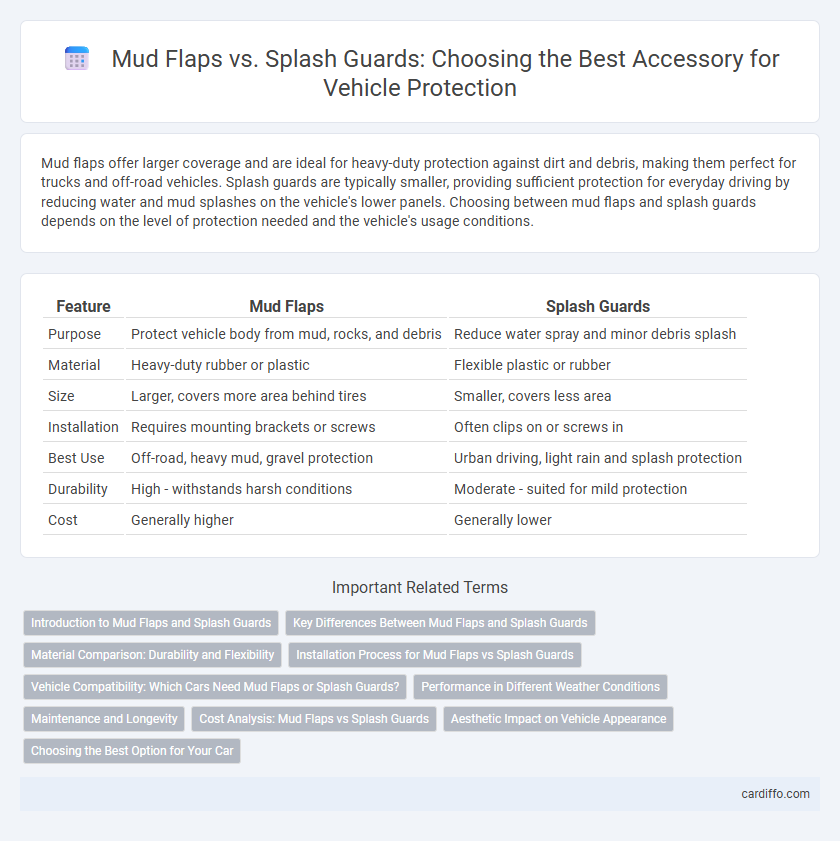Mud flaps offer larger coverage and are ideal for heavy-duty protection against dirt and debris, making them perfect for trucks and off-road vehicles. Splash guards are typically smaller, providing sufficient protection for everyday driving by reducing water and mud splashes on the vehicle's lower panels. Choosing between mud flaps and splash guards depends on the level of protection needed and the vehicle's usage conditions.
Table of Comparison
| Feature | Mud Flaps | Splash Guards |
|---|---|---|
| Purpose | Protect vehicle body from mud, rocks, and debris | Reduce water spray and minor debris splash |
| Material | Heavy-duty rubber or plastic | Flexible plastic or rubber |
| Size | Larger, covers more area behind tires | Smaller, covers less area |
| Installation | Requires mounting brackets or screws | Often clips on or screws in |
| Best Use | Off-road, heavy mud, gravel protection | Urban driving, light rain and splash protection |
| Durability | High - withstands harsh conditions | Moderate - suited for mild protection |
| Cost | Generally higher | Generally lower |
Introduction to Mud Flaps and Splash Guards
Mud flaps and splash guards serve as essential vehicle accessories designed to protect the undercarriage and paintwork from mud, water, and debris. Mud flaps typically feature a heavier, more durable material suited for off-road and heavy-duty use, while splash guards are lighter and often designed for everyday road conditions. Both accessories enhance vehicle safety by minimizing spray that can obstruct visibility for drivers behind.
Key Differences Between Mud Flaps and Splash Guards
Mud flaps are typically larger, made from durable rubber or plastic, and extend farther from the wheel to provide maximum protection against mud, rocks, and debris, making them ideal for off-road or heavy-duty use. Splash guards are more compact and designed to reduce water and minor debris spray, primarily enhancing vehicle aesthetics and preventing surface scratches. The key difference lies in their size, material thickness, and protection level, with mud flaps offering robust defense and splash guards providing lighter, everyday protection.
Material Comparison: Durability and Flexibility
Mud flaps are typically made from heavy-duty rubber, offering superior durability and resistance to harsh weather conditions and road debris, making them ideal for rugged use. Splash guards, often crafted from flexible plastic or thermoplastic materials, provide enhanced flexibility and are less prone to cracking under normal driving conditions. Choosing between the two depends on whether greater toughness or adaptability to vehicle contours is prioritized for long-term performance.
Installation Process for Mud Flaps vs Splash Guards
Mud flaps typically require drilling holes into the wheel well or fender liner for secure installation, which may involve specialized tools and increased installation time. Splash guards often come with a direct-fit design, using existing factory holes and clips, allowing for a quicker and less invasive installation process. Choosing between the two depends on the vehicle model and the installer's preference for either a permanent or easily removable accessory.
Vehicle Compatibility: Which Cars Need Mud Flaps or Splash Guards?
Mud flaps and splash guards are essential accessories designed to protect vehicles from mud, rocks, and water spray, with compatibility largely depending on the vehicle type and driving conditions. Trucks, SUVs, and off-road vehicles benefit most from mud flaps due to their larger tires and exposure to rough terrain, while compact cars and sedans often use splash guards to reduce water spray and debris on paved roads. Selecting the correct accessory ensures optimal protection tailored to the specific dimensions and clearance of each vehicle model, enhancing longevity and maintaining cleanliness.
Performance in Different Weather Conditions
Mud flaps provide superior protection against heavy mud and debris, making them ideal for wet and muddy conditions by preventing larger particles from striking the vehicle's body. Splash guards offer better performance in light rain and snow by reducing water spray and maintaining clearer visibility on the road. Both accessories enhance vehicle safety, but mud flaps excel in rugged, off-road environments while splash guards improve performance in regular wet weather driving.
Maintenance and Longevity
Mud flaps, typically made from heavy-duty rubber or plastic, offer enhanced durability and require minimal maintenance due to their thicker construction, making them ideal for long-term use in harsh conditions. Splash guards, often lighter and more flexible, may need more frequent inspection and replacement as they are prone to wear and tear from road debris and weather exposure. Choosing mud flaps over splash guards can result in lower maintenance efforts and extended longevity, especially for vehicles frequently driven on rough or muddy terrain.
Cost Analysis: Mud Flaps vs Splash Guards
Mud flaps generally cost between $15 and $50 per pair, offering a budget-friendly option for basic vehicle protection, while splash guards tend to range from $30 to $80, reflecting their enhanced durability and style. Installation costs for mud flaps are often lower due to simpler hardware requirements, whereas splash guards may require professional fitting, increasing overall expenses. Evaluating long-term value involves considering splash guards' improved resistance to wear and tear, which can reduce replacement frequency despite higher initial costs.
Aesthetic Impact on Vehicle Appearance
Mud flaps often have a rugged, utilitarian look that can complement off-road vehicles or trucks, enhancing a robust and practical aesthetic. Splash guards tend to be sleeker and less obtrusive, maintaining the vehicle's original design lines for a more subtle appearance. Choosing between mud flaps and splash guards depends on whether you prioritize a bold, aggressive style or a minimal, streamlined look for your vehicle.
Choosing the Best Option for Your Car
Mud flaps, made from durable rubber, provide robust protection against mud, rocks, and debris, making them ideal for off-road or heavy-duty driving conditions. Splash guards, often lighter and more flexible, offer sufficient coverage for everyday urban driving and help maintain car cleanliness by minimizing water splashes. Selecting between mud flaps and splash guards depends on your driving environment, vehicle type, and desired level of protection.
Mud flaps vs Splash guards Infographic

 cardiffo.com
cardiffo.com